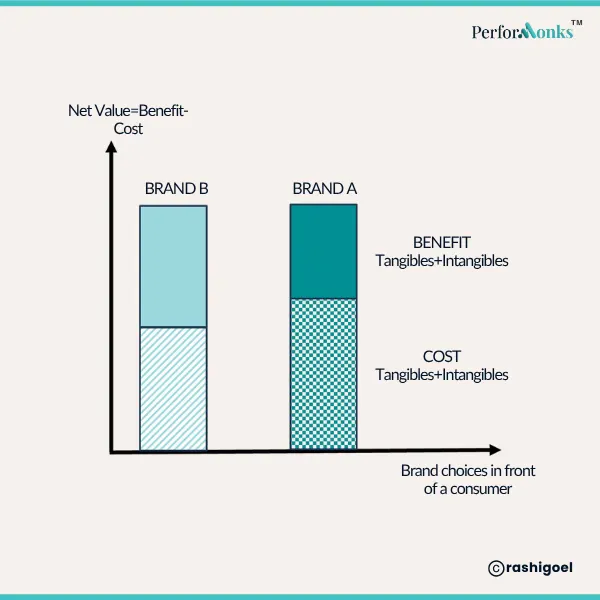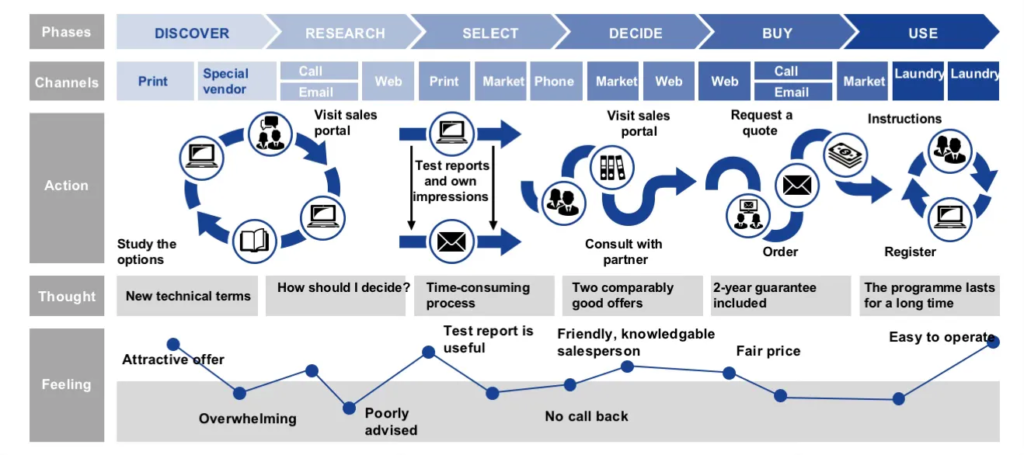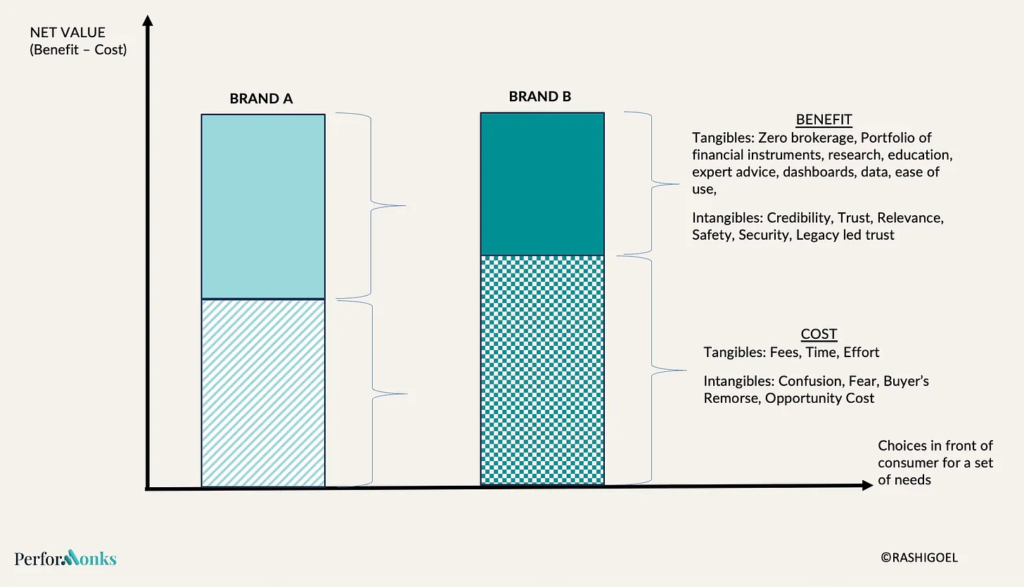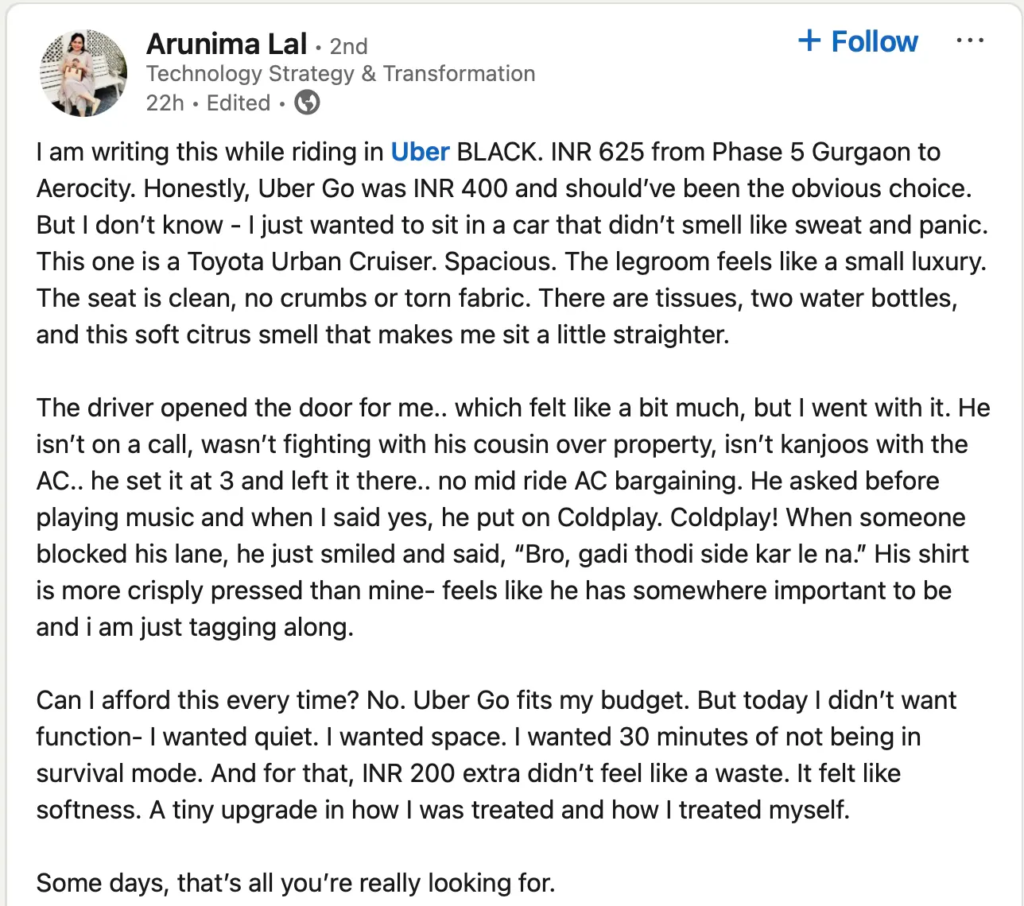Turns out, it’s not just about the money. It’s about net value. And net value is a fuzzy bundle of tangibles and intangibles.

Today’s newsletter is on how to spot these intangibles and how to use them to build meaningful differentiation.
- Consumers get fuzzy goodness and pay fuzzy costs.
- Not everything that can’t be measured is unimportant.
- How do we understand the fuzzy goodness that our consumers look for?
- Get curious about consumers’ stories.
- When fuzzy costs and goodness surprise you, then you know you are on the right path.
- Oftentimes, fuzzy goodness is visible within patterns of purchase.
- You can find consumer stories by lurking on social media platforms.
- Great brand opportunities are born to reduce fuzzy costs or to deliver more fuzzy goodness
- Even the most hard-nosed categories are packed with fuzzy costs and goodness. e.g. financial investment
- Even love, apart from a mother’s (maybe), is an ROI game.
- You know the best way to become self-aware and cultivate empathy?
Consumers get fuzzy goodness and pay fuzzy costs.
Not everything that can’t be measured is unimportant.
Fuzzy Cost: When we spend money to buy something, it’s not just money that we spend. We also spend our time and invest our emotions because each time we buy a product, we risk being disappointed or underwhelmed or even worse, regretting it.
I call this fuzzy cost because we can’t measure it. But just because we can’t measure it, does not mean it’s not there.
Frankly, businesses don’t think about this enough. Instead, we drop prices more often than porn stars shed their clothes. We obsess over Prime Day Sales and Independence Day Sales, thinking all we have to do is to drop prices and consumers will flock to our storefront.
Instead, we could increase the value we offer and keep the price the same.
I experienced this with a WPP agency when I was in Nestle. I was negotiating with them and wanted a discount. Their counter offer was that they would be unable to reduce the price but they would work on more projects for the same cost. Of course, we had to agree.
Fuzzy benefit: When we buy something, we get fuzzy goodness in return. The physical product itself is just a fraction of the value we pay for.
Like fuzzy cost, we can’t always identify or articulate fuzzy goodness in that moment.
So then how do we understand the fuzzy goodness that our consumers look for?
1) Get curious about consumers’ stories.
If you want to study fuzzy goodness, get very very curious and start asking consumers to share stories of why they bought what they did.
Ask questions that invite detailed descrptions because that’s where stories reside. Remember, fuzzy goodness and fuzzy costs live within stories.
“can you remember the moment when you took the decision to buy? Describe it in detail.”
“and then what happened? What did you do?”
“what all led to this moment?”
“even though you took the decision, did you still have some doubts nagging at you?”
“once you had used the product, did the doubts stay, reduce or increase?”
These stories also lie beneath the typical ‘discovery to advocacy’ consumer journeys we draft.
This is a consumer journey map Google surfaced, that does a semi-decent job of mapping fuzzy costs and goodness in the ‘Thought’ and ‘Feeling’ section. Semi-decent, because they could have embraced the fuzziness and emotional graph more in my opinion.

2) When fuzzy costs and goodness surprise you, then you know you are on the right path.
In one of his newsletters, Dharmesh Ba mentions that his dad, who is in his sixties and lives in a small town in South India, went to scout for a bank to open his first bank account.
He visited all the banks in his neighbourhood. He checked out interest rates, minimum balance requirements, distance from home, etc.
But in the end, he chose the bank whose manager wore a shirt and pants instead of the traditional Veshti.
When asked why, he said that he wanted professionals to manage his money and anyone with a ‘modern’ attire signalled education, aspiration and most of all, attested to the competence of that bank.
Bundles of fuzzy costs and goodness move in surprising ways. And only when we get truly deeply madly curious about how the human brain works can we start scraping the patina off to reveal the precious brass metal of insights.
3) Oftentimes, fuzzy goodness is visible within patterns of purchase.
Observe common underlying patterns and you might stumble upon fuzzy goodness a product delivers.
We think high ticket purchases rank very high on pricing. Not true. For instance, we hire McKinsey not for their insights, but for air cover – the CEO who hires McKinsey might buy himself a year or two more despite poor performance, because he can get away by saying, “we followed McKinsey’s recommendations”.
4) You can find consumer stories by lurking on social media platforms.
This, dear readers, is a consumer story packed to the brim with examples of fuzzy goodness and costs.
Fuzziness is an intangible, visceral experience, packaged inside a story. Not a bunch of Rs., ingredients, and features.
Capture this in a bottle and deliver it each time to your TAM. And you’ve got yourself a sustainable brand-led business.
Great brand opportunities are born to reduce fuzzy costs or to deliver more fuzzy goodness
Marketing at its most sophisticated level of mastery is about understanding what net value (fuzzy+tangible bundles of cost minus benefits) means to your consumer.
That’s why I think marketing is also a life skill. Because once you build this muscle of decoding net value, you can read your stakeholders, understand your spouse, and you are all set to tame this befuddling, crazy ride we call life.
Even the most hard-nosed categories are packed with fuzzy costs and goodness e.g. financial investment
This, for instance, is an example of net value calculation for a financial brokerage platform.

Whether we pay less for a new age discount broker or more for a legacy broker with experts on speed dial, what we are really paying for is certainty, trust, and sanity during volatile periods, because money management is exceptionally stressful.
Whether our destination is private jet wealth or a tiny home-on-wheels retirement cushion, we all go through the emotional roller coaster that stock market cycles put us through.
Brokerge brands can be positioned to alleviate this fuzzy cost
Here is a back of the envelope idea for a brokerage firm to differentiate itself from discount brokers promising get-rich-quick schemes.
A category reframe is that much like the bamboo that grows roots for at least 3 years before it sprouts noticeable shoots, there is no such thing as overnight riches.
The brand unlock. We offer human connect amidst AI-driven algorithms that keep you sane and ready to maximize returns even when the market dips.
Even love, apart from a mother’s (maybe), is an ROI game.
The most devoted couples break up if love is not reciprocated in the right measure. More and more, we find couples huddled together with their counsellors, trying to understand the other’s love language while also trying to decipher their own.
What they are really doing, is building self-awareness and learning empathy. And that dear readers, is the secret key that unlocks net value.
We don’t have to be quantum mechanics geniuses to math the net value of something. But we do have to be emotionally self-aware and empathetic. This takes more effort than learning quantum mechanics because humans are so complex.
You know the best way to become self-aware and cultivate empathy?
- Listen to stories.
- Tell stories.
In The Gilded Age, the old families (old money) of New York are hell bent on keeping the new families (nouveau riche) out.
The Russells are a new family, trying very hard to curry favour. So, they offer their grand ballroom for an upcoming charity function, only to be snubbed.
On day 1 of said charity event, Mr.Russell visits each stall (womanned by the old money ladies), and offers $100 to sell him everything they have. On the condition that they deliver all the goods to his house that very day.
This shuts down the charity event even before the entire setup is complete, when it had been planned for 3 days.
Financially, the event is an unprecendented success – they have raised more money than ever before. But the old money ladies pay a heavy fuzzy cost – they are not only idle for 3 days, but they also lose out on the sense of achievement and comaradeire from ‘earning’ the money through a 3-day group effort.
Mr. Russel earned status and power. As one of them said, “Yesterday, I would have said that [George Russell] was a nobody. But today? I’m obliged to concede that he is someone to be reckoned with.”
Never forget. It’s not just about the money.
More ways to connect
Watch my Tedx talk
Connect on LinkedIn
Visit my Website
Subscribe to this Newsletter
